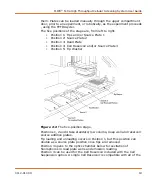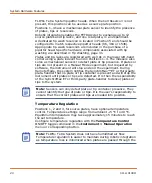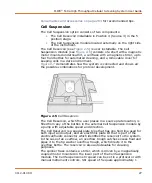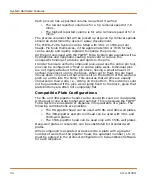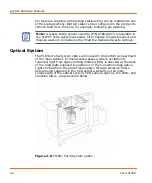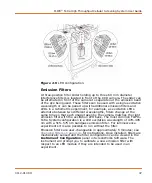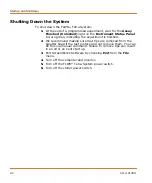
System Hardware Features
30
0112-0109 H
Each pin size has a specified volume range that it carries:
•
The lowest reported volume is for a tip removal speed of 7.8
mm/s.
•
The highest reported volume is for a tip removal speed of 57.0
mm/s.
The precise volumes that will be picked up at given tip removal speeds
should be determined by users in assay development.
The FLIPR
®
Tetra System can be fitted with 384- or 1536-pin tool
heads. Pin tools themselves, in the appropriate 384 or 1536 format,
can be easily and rapidly replaced to change the pin size.
All the pin tools used with the FLIPR
®
Tetra System are available with a
hydrophobic and lipophobic coating to prevent or reduce the
nonspecific binding of proteins and lipids to the pins.
In order to ensure uniform compound pick-up across the entire pin tool,
pins can be configured to ‘float’ in source plate wells. Individual pins
are not rigidly attached to the pin block, having a small amount of
vertical movement up into the block. When set to float, the pin head
moves down very low so that all pins sit on the bottom of the well and
push up a little into the block. This ensures that all pins are equally
immersed in their wells,
i.e.,
sitting on the bottom. This outcome could
not be guaranteed if the pins were rigidly fixed to the block, given that
plate bottoms are often not completely flat.
Compatible Plate Configurations
The 96- and 384-pipettor heads can be used with source or read plates
with equal or one order higher well number. This is because the FLIPR
®
Tetra System can aspirate or dispense into quadrants of a plate. The
following combinations are possible:
•
The 96-pipettor head can be used with 96- and 384-well plates.
•
The 384-pipettor and pin tool head can be used with 384- and
1536-well plates.
•
The 1536-pipettor head can be used only with 1536-well plates.
Deep-well plates or reservoirs can be substituted for standard well
plates.
When compound is aspirated or delivered to a plate with a greater
number of wells than the pipettor head, the quadrant number (1 to 4)
must be entered in the protocol configuration in ScreenWorks Software
for each dispense.
Summary of Contents for FLIPR Tetra
Page 1: ...FLIPR Tetra High Throughput Cellular Screening System User Guide 0112 0109 H December 2011...
Page 12: ...Contents 12 0112 0109 H...
Page 16: ...System Overview 16 0112 0109 H...
Page 40: ...System Hardware Features 40 0112 0109 H...
Page 148: ...Exchanging Hardware 148 0112 0109 H...
Page 156: ...Calibration and Signal Test 156 0112 0109 H...
Page 196: ...Running an Experiment 196 0112 0109 H...
Page 232: ...Robotic Integration 232 0112 0109 H The following drawings illustrate these requirements...
Page 282: ...Data Processing Algorithms 282 0112 0109 H...
Page 294: ...Consumables and Accessories 294 0112 0109 H...
Page 298: ...Using AquaMax Sterilant 298 0112 0109 H...
Page 302: ...Electromagnetic Compatibility EMC 302 0112 0109 H...




